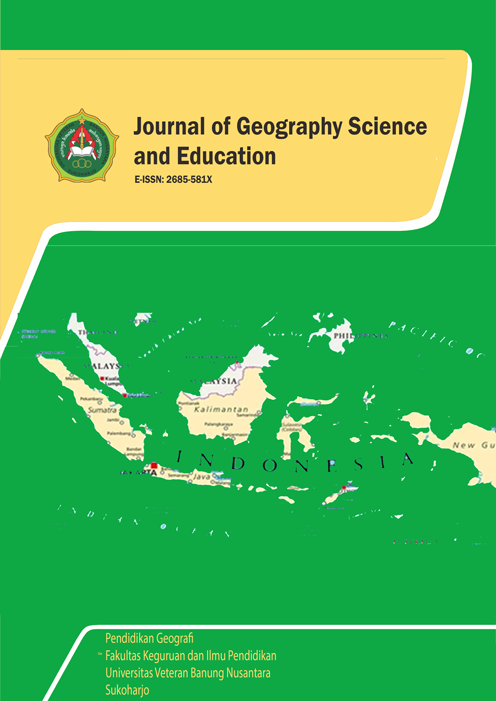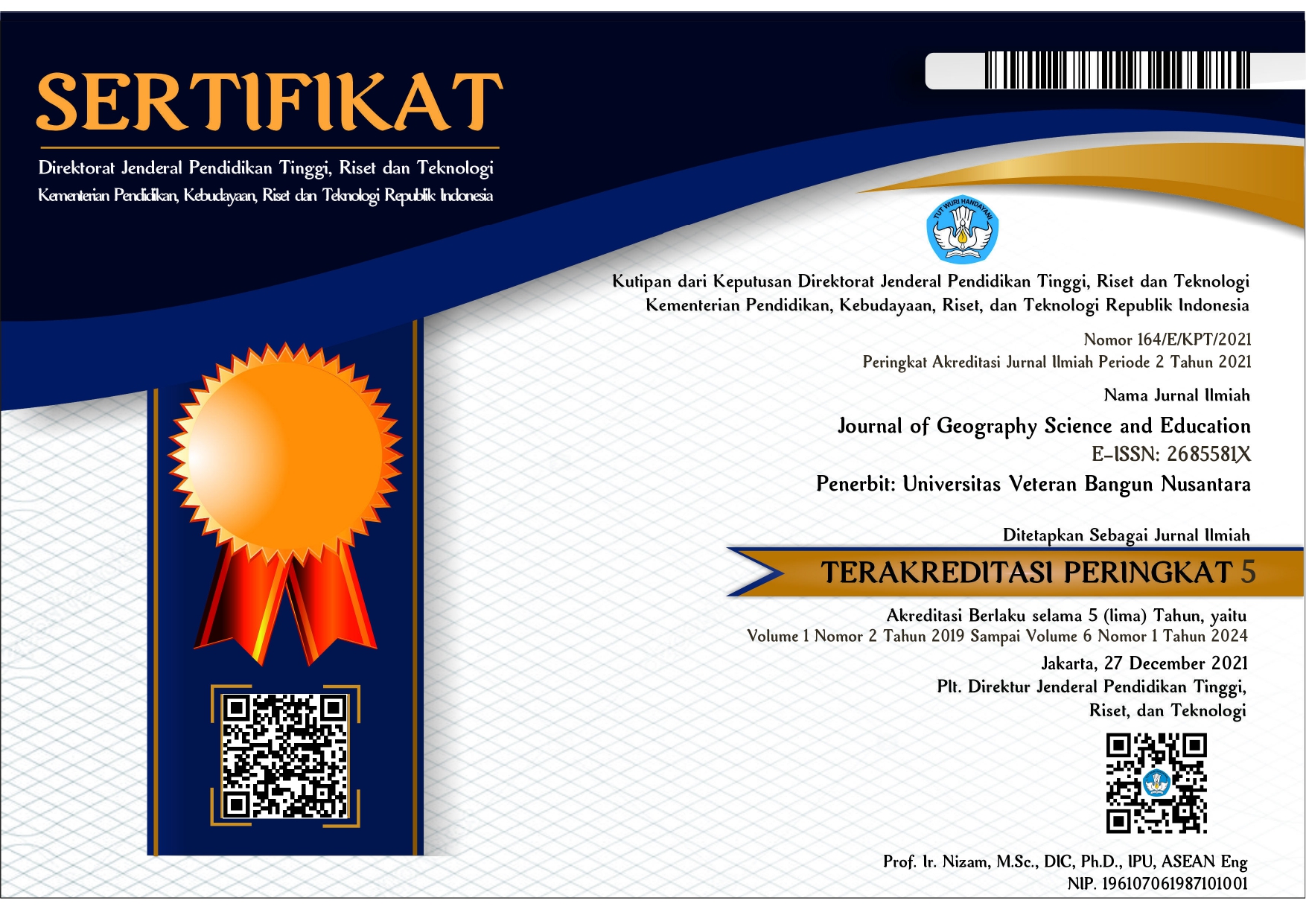Use Google Sites to Increase Interest Learning Geography High School in Sukoharjo
DOI:
https://doi.org/10.32585/jgse.v3i2.2063Kata Kunci:
Learning Media_1 Google Sites_2 Interest in learning_3Abstrak
Distance learning geography at one Tawangsari State High School uses the Google classroom, which still has several shortcomings that make learning geography less interesting. Increase interest in learning geography using Google Sites learning media. The research method used descriptive research method with a quantitative approach. The data collection technique used by giving tests and observations. giving pretest and posttest, for data analysis the post test is used. Observation is used to collect data on student activities in accessing google sites. Learning is considered successful if the learning outcomes of students with the provision that at least 80% of students in one class reach the minimum completeness criteria, namely 75. The results of student observations in accessing learning media google sites can be seen that from 36 students, very good information there are 19 students with a percentage of 53% then increase in posttest test results by 11 students who completed with a percentage of 31% increased to 32 students who completed with a percentage of 89%. So it that google sites-based learning media can increase the learning interest of eleventh grade Social Sciences three students learning geography at one Tawangsari State High School in 2021.Unduhan
Referensi
Ahmad Zaki, D. Y. (2020, Juli-Desember). Penggunaan Media Pembelajaran untuk meningkatkan Prestasi Belajar Siswa pada Pelajaran PKN di SMA Swasta Darussa'adah Kec.Pangkalan Susu. Jurnal Ilmu Pendidikan, Vol.7, 809-820.
Arinda Evandian Bhagaskara, A. K. (2021, June). Penerapan Media Webquest Berbasis Google Sites dalam Pembelajaran Masa Pandemi Covid-19 di MI Bilingual Roudlatul Jannah Sidoarjo. Jural Bidang Pendidikan Dasar, Vol 5, 104-119.
Irma, S. (2019, Desember). Analisis Minat Belajar Siswa Menggunakan Model Problem Based Learning dengan Pendekatan Stem pada Materi Vektor di Kelas MIPA 3 SMA N 2 Jember. Jurnal Sudi Islam Pancawahan, Vol 14, 87-99.
Jubaidah, S. (2020). Penggunaan Google Sites pada Pembelajaran Matematika Materi . Jurnal Ilmu Kependidikan, Vol 15, 68-73.
Nihayah, U. (2017, Juli). Perbandingan Hasil belajar Menggunakan Metode Question Student Have dan metode Pembelajaran Konvesional pada mata Pembelajaran geografi Materi pokok Hidrosfer Siswa Kelas X Madrasah Aliyah Nadhlatusy Syubban Jepara. Jurnal geografi, Vol 12, 125-221.
Nurkholis. (2018, November). Pendidikan dalam Upaya Memajukan Teknologi. Jurnal Kependidikan , Vol 1, 24-44.
Raja, A. (2016, Juli). Meningkatkan Keaktifan dan Hasil Belajar Geografi Tentang Sebaran Barang Tambang di Indonesia Melalui Gabungan Model Pembelajaraan Pture dan Group Investigation Bagi Siswa Kelas XI IPS @ SMA Negeri 8 Surakarta tahun 20215 ic. Jurnal GeoEco, Vol 2, 155-161.
Shab, i. J. (2020, April). Studi Deskriptif Kuantitatif Tentang Aktifitas Belajar Mahasiswa dengan Menggunakan Media Pembelajaran Edmodo dalam Pembelajaran Sejarah. Jurnal Artefak, Vol 7, 13-20.
Steffi Adam, M. T. (2015). Pemanfaatan Media Pembelajaran Berbasis Teknologi Informasi Bagi Siswa Kelas X SMA Ananda Batam. CBIS Journal, 3, 78-90.
Suryaman, D. S. (2021, Juli). Penggunaan Media Pembelajaran Google Sites dalam Pembelajaran Bahasa Inggris Kelas V SD. Jurnal teknologi Pendidikan, Vol 6, 20-31.
Widiya Mutiara Mukti, Y. B. (2020). Media Pembelajaran Fisika Berbasis Web Menggunakan Google Sites pada Materi Listrik Statis. Webinar Pendidikan Fisika , 51-59.
Unduhan
Diterbitkan
Cara Mengutip
Terbitan
Bagian
Lisensi
License and Copyright Agreement
In submitting the manuscript to the journal, the authors certify that:
- They are authorized by their co-authors to enter into these arrangements.
- The work described has not been formally published before, except in the form of an abstract or as part of a published lecture, review, thesis, or overlay journal. Please also carefully read JGSE's Posting Your Article Policy at http://pubs2.ascee.org/index.php/ijele/about/editorialPolicies#custom-5
- That it is not under consideration for publication elsewhere,
- That its publication has been approved by all the author(s) and by the responsible authorities – tacitly or explicitly – of the institutes where the work has been carried out.
- They secure the right to reproduce any material that has already been published or copyrighted elsewhere.
- They agree to the following license and copyright agreement.
Copyright
Authors who publish with Journal of Geography Science and Education agree to the following terms:
- Authors retain copyright and grant the journal right of first publication with the work simultaneously licensed under a Creative Commons Attribution License (CC BY-SA 4.0) that allows others to share the work with an acknowledgment of the work's authorship and initial publication in this journal.
- Authors are able to enter into separate, additional contractual arrangements for the non-exclusive distribution of the journal's published version of the work (e.g., post it to an institutional repository or publish it in a book), with an acknowledgment of its initial publication in this journal.
- Authors are permitted and encouraged to post their work online (e.g., in institutional repositories or on their website) prior to and during the submission process, as it can lead to productive exchanges, as well as earlier and greater citation of published work.
Licensing for Data Publication
Journal of Geography Science and Education use a variety of waivers and licenses, that are specifically designed for and appropriate for the treatment of data:
- Open Data Commons Attribution License, http://www.opendatacommons.org/licenses/by/1.0/ (default)
- Creative Commons CC-Zero Waiver, http://creativecommons.org/publicdomain/zero/1.0/
- Open Data Commons Public Domain Dedication and Licence, http://www.opendatacommons.org/licenses/pddl/1-0/
Other data publishing licenses may be allowed as exceptions (subject to approval by the editor on a case-by-case basis) and should be justified with a written statement from the author, which will be published with the article.
Open Data and Software Publishing and Sharing
The journal strives to maximize the replicability of the research published in it. Authors are thus required to share all data, code or protocols underlying the research reported in their articles. Exceptions are permitted but have to be justified in a written public statement accompanying the article.
The associated persistent identifiers (e.g. DOI, or others) of the dataset(s) must be included in the data or software resources section of the article. Reference(s) to datasets and software should also be included in the reference list of the article with DOIs (where available). Where no domain-specific data repository exists, authors should deposit their datasets in a general repository such as ZENODO, Dryad, Dataverse, or others.
Small data may also be published as data files or packages supplementary to a research article, however, the authors should prefer in all cases a deposition in data repositories.










